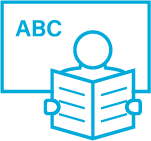Completely Illiterate Adults Can Learn to Decode in 3 Months

The purpose of this case series was to explore whether adults who did not have the opportunity to acquire reading skills during childhood were able to do so rapidly if trained with an adequate literacy programme. After 14 weeks of training with a new, optimised, literacy course based on cognitive research, 6 out of 8 participants were able to read words they had never encountered.
Authors: Régine Kolinsky, Isabel Leite, Cristina Carvalho, Ana Franco & José Morais
Source: Kolinsky, R., Leite, I., Carvalho, C., Franco, A., & Morais, J. (2019). Completely illiterate adults can learn to decode in 3 months. Read Writ, 31, 649–677 https://doi.org/10.1007/s11145-017-9804-7
The purpose of this case series was to explore whether adults who did not have the opportunity to acquire reading skills during childhood were able to do so rapidly if trained with an adequate literacy programme. After 14 weeks of training with a new, optimised, literacy course based on cognitive research, 6 out of 8 participants were able to read words they had never encountered. They also showed enhanced phonemic sensitivity and phonological memory. Thus, there is no major plasticity impediment preventing the rapid eradication of illiteracy in adults.
- According to the most recent worldwide data for 2005–2014, 15% of people aged at least 15 years lacked any reading and writing skills (UNESCO, 2016).
- This high rate is mainly explained by the lack of adequate learning opportunities.
- Due to socioeconomic or cultural reasons, many people do not attend school during childhood, or they only go for some months or years on an irregular basis.
- Literacy and schooling are considered human rights, thanks to the growing recognition that adult illiteracy often condemns the individual to poverty, poor health, and social exclusion (not only the adults but also their children).
- Although reading can clearly be taught to adults, only a few learners become fluent readers at the end of a literacy course.
- The available evidence does not support the assumption that there is a sensitive period for reading development during childhood or even until at least middle adulthood.
- The scarcity of information in the majority of adult literacy studies concerning instruction methods, time devoted to instruction, and the level of ability before and after instruction, makes it difficult to assess the effects of literacy programmes rigorously.

Present study
The authors of the present study elaborated a new literacy course aimed at optimising reading acquisition and applied it to a small group of completely illiterate women, while fully controlling the instruction provided and repeatedly measuring its effects.
The literacy course principles
Literacy for illiterate adults (LIA) is based on the phonics approach, with four overarching principles:
- To develop comprehension of the alphabetic principle; namely, that letters (alone or in combination [graphemes]) stand for phonemes;
- To teach the orthographic code; namely, the correspondences between graphemes and phonemes (GPCs) in a progressive way from the simplest to the most complex, capitalising on current knowledge about the possible stumbling blocks in reading acquisition;
- To teach lower- and upper-case letters in parallel; and
- To combine reading and handwriting activities systematically.
The literacy course outline
- The phonics approach is reported to elicit the best results among both children and adults.
- Reading an alphabetic script is contingent on understanding the alphabetic principle, while phonemic awareness develops hand in hand with the acquisition of this principle as illustrated by the fact that it is virtually absent in illiterate adults.
- LIA combines opportunities for insight and learning of GPCs of increasing level of difficulty, which is the best way to teach word decoding.
- Initially, student attention is directed to the phonological length of word pairs displaying an incongruent relation to the size of the referents as well as to the number of syllables included in these words, and their associated articulatory gestures.
- Next, LIA relates the notion to the length of written words, illustrating that phonologically longer words need (in principle) more letters to be written than phonologically shorter words.
- After exercising this approximate correspondence, each syllable is isolated in turn, illustrating the left-right directionality of reading/writing (a notion that illiterate adults also lack).
- Still in the first lesson, phonemic awareness and the understanding of the alphabetic principle are then promoted by insisting simultaneously on sounds, articulatory gestures, and letters.
- The understanding of the alphabetic principle is then tested using new consonant–vowel (CV) combinations.
- To decode implies to master the language’s orthographic code.
- The order of GPCs teaching in LIA obeys five principles:
- Phoneme accessibility: from the easiest to the most difficult
- Degree of consistency: from higher to lower
- Grapheme complexity: from simpler to more complex
- Visual difficulty of letter recognition: from letter pairs of higher to lower visual discriminability
- Phonological structure: from simpler to more complex syllabic environment
- The course is subdivided into 17 modules of increasing complexity; each module is taught in 2 or 3 lessons for a total of 41 lessons and corresponds to the introduction of 1 (or more) GPCs, concepts, or orthographic rules.
- For instance, the first two modules (five lessons) focus exclusively on the acquisition of the alphabetic principle and therefore only present simple letters.
- Inconsistent GPCs are introduced in Module 3 together with unstressed vowels and a new structure.
- Some simple contextual and positional rules are introduced in Modules 4–6, together with simple digraphs.
- New graphemes and syllabic structures are added progressively; however, plosives and mirrored letters do not appear before Modules 11 and 12, respectively.
- The 17th and final module is devoted to highly inconsistent letter(s).
- The third overarching principle of LIA (that lower- and upper-case letters are taught in parallel) was motivated by the fact that mastering the alphabet requires the acquisition of abstract letter units to consider as identical symbols that may be physically quite different.
- The last overarching principle (that reading and handwriting are taught and exercised jointly throughout the course) was not meant to allow written production to develop substantially in the very short instruction that was used. However, training handwriting may benefit reading acquisition.
Assessing the effectiveness of LIA
- LIA was applied to 8 illiterate women for 3 lessons (of 2 h each) per week over 14 weeks.
- Each lesson (except the first) began with revision.
- Students also received homework.
- Participants were tested before, during, and after the course.
- Tests included students’ letter and complex grapheme knowledge, their ability to match letters across case, their reading and meta-phonological abilities, and phonological memory.

Findings
- All participants learned to recognise single letters.
- Performance was lower on complex graphemes with two participants still struggling after the course, although progress was significant.
- Matching physically different letters was initially easier for letters that are similar across case than for dissimilar ones; however, this difference decreased over time.
- Post-intervention, progress in reading was robust except for one participant who did not learn to read at all. Among the others, there were strong individual differences in overall reading scores after the intervention, ranging from 43% to 88% for words presented in the classroom, and from 21% to 85% for new words.
- Individual progress was sounder for upper- compared to lower-case items, and for old compared to new words.
- Still, performance on both new and old words was far from perfect after the intervention as most students still struggled with items including a nasal digraph.
- Performance significantly improved for two of the three meta-phonological tests (namely, phonemic sensitivity and syllable deletion); however, not for the more difficult phoneme deletion test (except for one participant).

Conclusions and implications
- Overall, the LIA course yielded a significant improvement in almost all the evaluated abilities.
- Throughout the learning period, there was a steady increase in the knowledge of simple letters and to a lesser (but still significant) extent of complex graphemes.
- At any test session, performance improved only for the studied GPCs. For these, progress was rapid and was maintained at further testing sessions.
- The students (entirely illiterate at the beginning) clearly learned to decode, an indispensable condition to becoming autonomous readers.
- Many new words were read perfectly post-intervention, which shows that students developed a genuine decoding ability rather than resorting to whole-word pattern recognition.
- Nevertheless, as expected, words that had been presented in the classroom were read slightly better than new words, although the difference post-intervention was not significant.
- Reading new pseudowords remained slightly more difficult than reading new words, and clearly more difficult than reading words that had been presented in the classroom.
- Scores in meta-phonological tasks increased through successive test sessions.
- Performance on syllable deletion and phonemic sensitivity began to improve even before learning to read, which is consistent with the idea that those abilities may benefit from such learning whilst not depending on it.
- Large individual differences were observed in participant learning curves, with individual performance remaining near 0 or increasing by 60% or even more than 90%, in particular for knowledge of complex graphemes and word reading.
- Only one student failed to learn to read at all; she was the oldest (64 years old) and least motivated of the participants.
- The present results clearly show that a total of 82 h training delivered throughout 3 months is insufficient to progress beyond slow and effortful decoding.
- This is particularly relevant considering adult literacy courses are often quite limited in instruction time.
- Longer and more intensive training is most likely required to become a fluent reader.